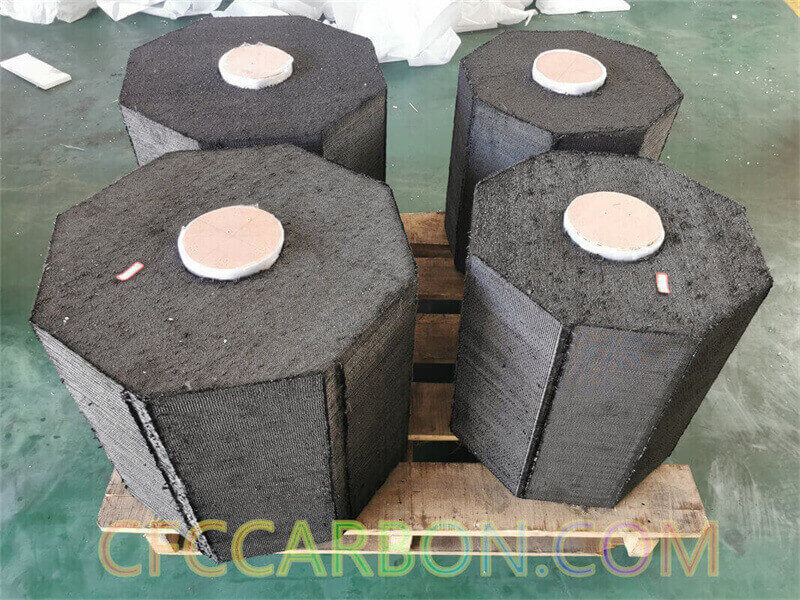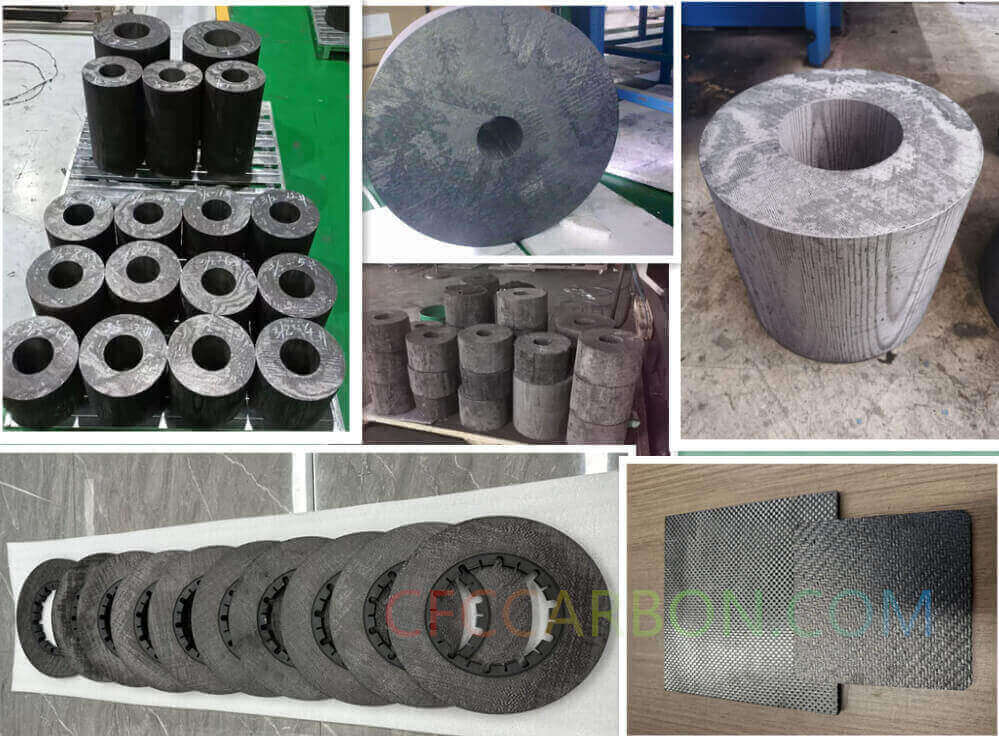The out-of-plane, off axis and transverse properties of unidirectionally reinforced carbon composites depend mostly on the properties of the matrix or matrix-fiber bond. Specific properties of interest include transverse modulus, strength, and interlaminar shear strength. Using a simple model, an approximate value for the transverse modulus of a unidirectionally reinforced carbon composite Ect can be extimated
![]() (5)
(5)
Where Em and Ef are modulus values for the transverse direction of the carbon composite; Vm and Vf are the respective volume fractions of

3D 4D CFC carbon fiber composite preform-preforming-Prefab (2)
the matrices. Although this expression neglects porosity and some other important effects, it can be used to reach the reasonable conclusion that in well-bonded carbon composites, for the usual fiber volume fractions, the transverse modulus will never be greater than about twice the modulus of the matrix. In the absence of constraint, transverse strength can never be greater than the strength of the matrix. It is believed that in well-bonded carbon composites the transverse strength will be independent of volume fraction of fibers and approximately equal to the strength of the matrix. Conversely, in a poorly bonded carbon composite, a dependence on volume fraction will be observed and strengths appreciably lower than the strength of the matrix will be expected.
The results of Perry and Adams who studied three types of resin matrices and different fiber types support the conclusion that larger values of transverse strength, modulus, and interlaminar shear are obtained from carbon composites reinforced with well-bonded fibers. Although several fiber types were investigated, it appears that bonding is controlled by the reactivity of the matrix and the fiber. All properties improved with densification up to the fourth cycle and, in general, heating to graphitization, although degrading the transverse

2D 3D 4D 5D carbon fiber composite material manufacturer factory -airplane brake disc plates sheets U L profiles-2D(6)
tensile strength caused no degradation in interlaminar shear values. Carbon-fiber-reinforced carbonized Borden SC-1008 phenolic exhibited a maximum transverse strength of about 870 psi which degraded to about 700 psi or less when heated to graphitization temperatures. A similar degradation from a maximum of 680 psi to less than 500 psi occurred for carbon-fiber-reinforced PPQ resin char and from 760 psi to 450 psi for the reinforced FF-26 resin char. In most cases, values of interlaminar shear varied between 3000 psi to 3600 psi for the SC-1008, about 2100 psi for the PPO, and about 2600 psi for the FF-26. Interlaminar shear strengths for carbonized pitch densified materials appear to be superior to resin-char matrices. Values of 3915 psi have been quoted for resin pitch-densified material.
In the late 1970’s, Thomas and Walker studied CVD-densified carbonized resin chars reinforced with a series of commercially available fibers, some of which were surface treated. Apart from naturally reactive fibers, surface treatment improved the transverse flexural strength slightly while the interlaminar shear was increased significantly. Subsequent carbonization and redensification always produced carbon composites with matrix-dominated properties lower than the reinforced precursor; however, the superiority of the surface-treated material always remained after heat treatment. Unfortunately, as discussed before, a good fiber-matrix bond reduced the value of the fiber-dominated longitudinal strength, and the fracture mode became very brittle. Depending on fiber type and the presence or absence of surface treatment, values of transverse flexural strength exhibited by the CC material varied from about 2030 psi to 4350 psi; values of interlaminar shear varied from 2320 psi to 3915 psi.
The apparent superiority in matrix-dominated properties of the CVD-densified material when compared to resin-densified material is supported by the work of Walker and Lee who indicate that both transverse tension and interlaminar shear of 2D CC are superior if the matrix is prepared by chemical vapor deposition. These authors indicated interlaminar tensile strengths of about 790 psi and interlaminar shear strengths of 2340 psi for carbonized resin precursor material compared with 1460 psi and 2740 psi for CVD material. In this work, it was pointed out that the superiority of CVD was only true for thin materials because reductions of both interlaminar tensile and interlaminar shear strengths occurred when the thickness of the CVD-densified material approached 0.5 in. This property degradation was shown to be related to the degree of difficulty in fully densifying chick sections using CVD.
The results reported in the literature are difficult to interpret because varying one parameter while keeping other factors constant is difficult. The matrix-dominated properties depend on fiber type, surface reactivity, matrix type (resin precursor, CVI microstructure, and pitch precursor), matrix reactivity, fiber volume fraction, processing condition, degree of densification, fiber orientation, and laminate thickness. By optimizing all these parameters, the matrix-dominated properties can be maximized; however, the greatest improvement in these properties is obtained by placing fibers in the appropriate directions.
Contact Us
related news /articles:
Influence of matrix on elastic modulus of carbon composite properties
Effect of surface treatment and sizing on composite properties
Carbon fiber reinforced composites manufacturer in China
Effect of surface treatment and sizing on composite properties